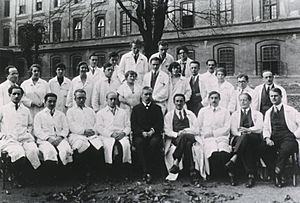Alexandra Adler facts for kids
Quick facts for kids
Alexandra Adler
|
|
|---|---|

Julius Wagner-Jauregg's staff in 1927
|
|
| Born | 24 September 1901 Vienna |
| Died | 4 January 2001 |
| Occupation | Psychiatrist, neurologist |
Alexandra Adler (born September 24, 1901 – died January 4, 2001) was an important Austrian neurologist. She was the daughter of psychoanalyst Alfred Adler, a very famous thinker. Alexandra Adler is known for helping to explain and organize her father's ideas, called Adlerian psychology. She was also a pioneer in understanding how the brain works and how people deal with difficult experiences.
Contents
Alexandra Adler's Career
Alexandra Adler finished her medical studies at the University of Vienna in 1926. She then chose to specialize in psychiatry, which is the study of mental health. In 1935, she moved to the United States. There, she taught neurology at the famous Harvard Medical School.
In the same year, 1935, she started a publication called the Journal of Psychology. Later, in 1938, she became the medical director of the Alfred Adler Clinic. This clinic was named after her father. In 1946, she joined the psychiatry department at New York University College of Medicine. She became a full professor there in 1969. Alexandra Adler also served as the president of the American Society of Adlerian Psychology.
Important Medical Studies
Alexandra Adler conducted many important studies that helped us understand the human brain and mind better.
Encephalitis Investigation
From 1928 to 1938, Alexandra Adler studied cases of encephalitis (a brain inflammation) at the Boston City Hospital. She looked at over 100 patients. Her goal was to learn more about these brain diseases. She wanted to understand how they affected people.
Multiple Sclerosis Research
In 1937, Adler worked with a brain surgeon named Tracy Putnam. They studied the brain of someone who had multiple sclerosis (MS). MS is a disease that affects the brain and spinal cord. Their research gave new information about how MS impacts the body. Pictures from their study are still used in medical books today.
Cocoanut Grove Fire Study
In 1943, Adler studied people who survived the terrible Cocoanut Grove nightclub fire in 1942. She found that even a year after the fire, half of the survivors still had serious problems. These problems included trouble sleeping, feeling very anxious, guilt, and fears related to the event. They also had changes in their personalities.
Adler noticed that survivors often remembered only parts of what happened. She thought this might be because of the extreme stress or possibly brain damage from carbon monoxide. Her work was one of the first detailed studies of what we now call post-traumatic stress disorder (PTSD). PTSD is a condition that can happen after a very shocking or scary event.
Continuing Adlerian Psychology
In the 1950s and 1960s, Alexandra Adler continued her father's work. She explored how Adlerian psychology could help treat conditions like schizophrenia, neuroses (anxiety disorders), and personality disorders. She believed that combining her father's ideas with modern medicine and group therapy could help people.
See also
 In Spanish: Alexandra Adler para niños
In Spanish: Alexandra Adler para niños


